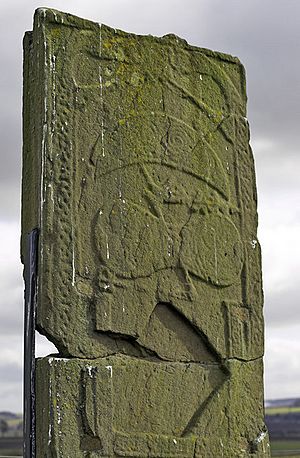St Orland's Stone facts for kids
The St Orland's Stone is a special ancient stone found in Scotland. It's also called the Cossans stone or the Cossins stone. This stone is a type of Pictish Cross-Slab, which means it has a cross carved on one side and mysterious symbols on the other. It's located near the towns of Kirriemuir and Forfar in a place called Cossans, in Angus, Scotland.
Contents
Where to Find St Orland's Stone
This ancient stone stands in its original spot, which is quite rare! You can find it about 3 kilometers (or 1.8 miles) southwest of the A926 road. It's located roughly halfway between the towns of Kirriemuir and Forfar, in an area that used to be part of Glamis parish.
What Does St Orland's Stone Look Like?
The St Orland's Stone is a large, carved slab made from a type of rock called Old Red Sandstone. It stands about 2.4 meters (nearly 8 feet) tall, is about 0.7 meters (2.3 feet) wide, and 0.25 meters (about 10 inches) thick. Both sides of the stone have detailed carvings that stick out from the surface, a style known as "relief" carving. Because it features both a Christian cross and older Pictish symbols, experts call it a Class II Pictish stone.
The Cross Side
One side of the stone shows a beautiful Celtic cross with a ring around its center. This cross is covered in amazing patterns of knotwork and swirling designs. Below the cross, you can see strange, mythical animals with their bodies twisted into intricate knots. The edges of the stone also seem to have had knotwork patterns, but they are now worn down by time and weather.
The Symbol Side
The back of the stone is just as interesting! It features two well-known Pictish symbols:
- A crescent moon shape with a V-rod.
- A double disc shape with a Z-rod.
Below these symbols, there's a scene that looks like a hunting party. You can see four people riding horses, with two dogs running alongside them. Even further down, there's a picture of a boat filled with passengers. Next to the boat, a strange, fantastic beast seems to be facing or even attacking a bull.
You might notice a missing square section between the Pictish symbols and the hunting scene. It looks like this part was either cut out or had something special inlaid there that has since been removed. The entire carving on this side is framed by more beautiful, interwoven knotwork patterns.
How the Stone Was Repaired
Over many years, the St Orland's Stone broke at some point. To fix it, people used strong iron staples. These staples were originally placed on the flat faces of the stone, but they have since been moved to the edges to help keep the stone together and make it stronger.


